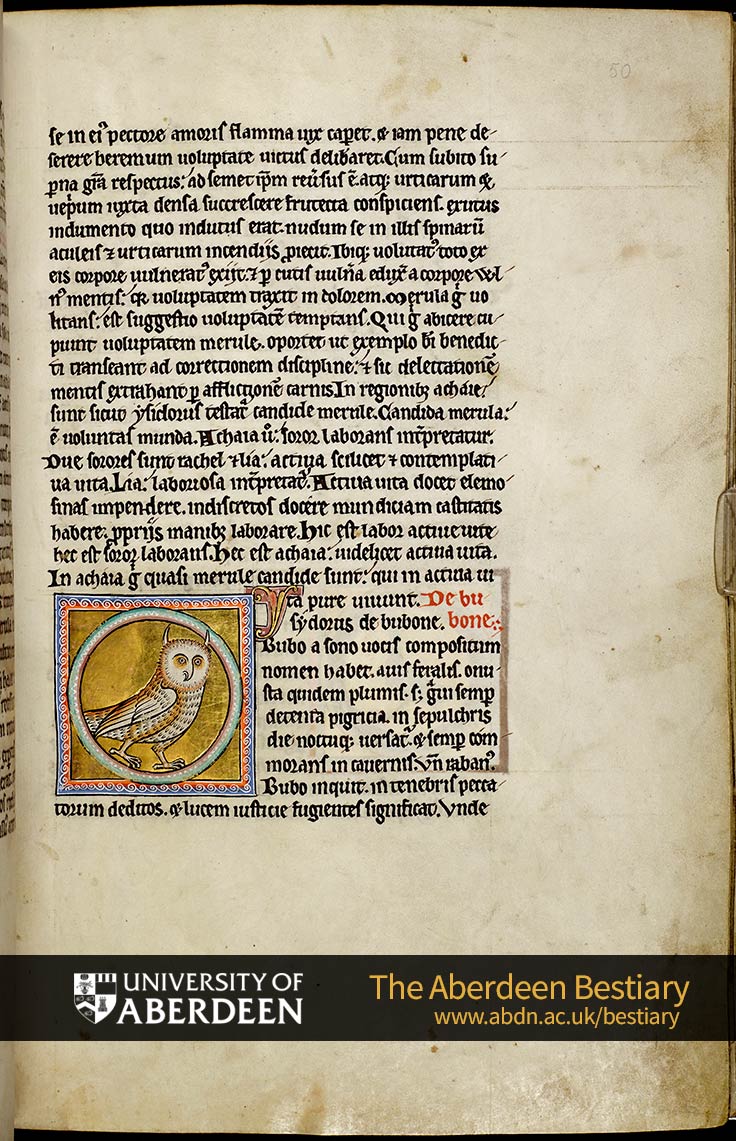- Commentary
-
Commentary
Text
Rolling in nettles saves St Benedict from lust. The Owl.
Illustration
Portrait of the owl.
Comment
This owl 'bubo' is tawny brown and beige with a flat face and prominent ears like horns. Bubo, as described by Aristotle (buas or bruas in Greek) was as large as an eagle which must indicate the relatively rare eagle owl. It has prominent ear tufts as shown but it is tawny all over and does not have a flat face. The long eared owl has a flat face and ears but is also tawny all over. The barn owl is closest in colouring to the illustration and also has a flat face, but it does not have ears. As projecting ears or horns are not mentioned in the Bestiary text they may derive from a much earlier source which was still aware of the connection between bubo and the eagle owl. Initial, type 2. It is squeezed into its space and is over lapped by the illustration.
Folio Attributes
- Transcription and Translation
-
Transcription
se in eius pectore amoris flamma vix caperet, et iam [PL ut etiam] pene de\ serere heremum voluptate victus deliberaret. Cum subito su\ perna gratia respectus, ad semetipsum reversus est, atque urticarum et\ veprium iuxta densa succrescere frutecta conspiciens, exutus\ indumento quo indutus erat, nudum se in illis spinarum\ aculeis et urticarum incendiis proiecit. Ibique volutatus toto ex\ eis corpore vulneratus exiit, et per cutis vulnera eduxit a corpore vul\ nus mentis, quia voluptatem traxit in dolorem. Merula igitur vo\ litans, est suggestio voluptatem temptans. Qui igitur abicere cu\ piunt voluptatem merule, oportet ut exemplo beati Benedic\ ti transeant ad correctionem discipline, et sic delectationem\ mentis extrahant per afflictionem carnis. In regionibus Achaie\ sunt sicut Ysidorus testatur candide merule. Candida merula,\ est voluntas munda. Achaia vero, soror laborans interpretatur.\ Due sorores sunt Rachel et Lia, activa scilicet et contemplati\ va vita. Lia, laboriosa interpretatur. Activa vita docet elemo\ sinas impendere, indiscretos docere mundiciam castitatis\ habere, propriis manibus laborare. Hic est labor active vite,\ hec est soror laborans. Hec est Achaia, videlicet activa vita.\ In Achaia igitur quasi merule candide sunt, qui in activa vi\ ta pure vivunt. \ De bubone \ Ysidorus de bubone.\ Bubo a sono vocis compositum\ nomen habet, avis feralis, onu\ sta quidem plumis, sed gravi semper\ detenta pigricia, in sepulchris\ die noctuque versatur et semper com\ morans in cavernis. Unde Rabanus:\ Bubo inquit, in tenebris pecca\ torum deditos, et lucem iusticie fugientes significat. Unde\Translation
the flame of his love could scarcely contain itself in his breast and, overcome by desire, he now almost resolved to quit the wilderness. When suddenly, touched by the grace of heaven, he recovered himself, and seeing thick bushes of nettles and thorns growing nearby, he stripped off the garment he was wearing and threw himself naked amid the pricking thorns and stinging nettles. And having rolled in them, he emerged with his body covered in wounds, and through these wounds to his skin he discharged from his body the wound to his soul, because he transformed his desire into pain. The blackbird in flight, therefore, represents enticement, tempting you to desire. If you want, therefore, to reject the desire symbolised by the blackbird, you must follow the example of the blessed Benedict and turn instead to the correction of discipline and thus rid yourself of pleasures of the mind by inflicting pain on your flesh. In the regions of Achaia, according to Isidore, there are white blackbirds. A white blackbird represents purity of will. But by Achaia we understand the industrious sister. There are two sisters, Rachel and Leah, namely the active and the contemplative life. Leah we take to be the industrious one. The active life teaches us to devote ourselves to works of charity, to teach men who lack discernment, to have the purity of chastity, to work with our own hands. This is Achaia, the active life. In Achaia, therefore, like the white blackbirds, live those who live chastely the active life. Of the owl Isidore says of the owl: 'The name owl, bubo, is formed from the sound it makes. It is a bird associated with the dead, weighed down, indeed, with its plumage, but forever hindered, too, by the weight of its slothfulness. It lives day and night around burial places and is always found in caves.' On this subject Rabanus says: 'The owl signifies those who have given themselves up to the darkness of sin and those who flee from the light of righteousness.' As a result

